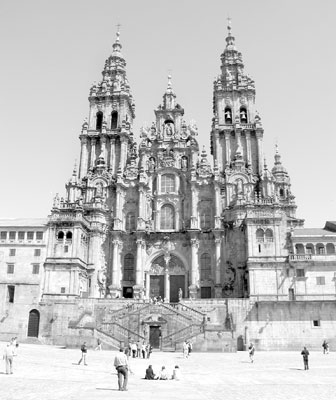Pilgrim’s progress in Santiago de Compostela
Santiago de Compostela, the Spanish cathedral housing the relics of St. James, has long exerted a powerful pull on travelers. For over a thousand years, pilgrims from all walks of life and all corners of the globe have trod the rugged trail from France across northern Spain in a spiritual quest for forgiveness and healing.
Arriving at the cathedral square, millions of tired sojourners have taken a deep breath and thought, “I made it!” The city has a festive, hippie-like atmosphere as travelers celebrate the end of a long journey.
In medieval times the city must have had a more somber air. On cathedral square you’ll see the Hospital of the Catholic Kings. In medieval times, sick pilgrims each sought the saint’s help in overcoming their illness, though the long trek to Santiago only made their condition worse. Spain’s 16th-century rulers, Isabel and Ferdinand, who came here to give thanks for conquering the Moors, were so moved by the plight of the sick that they built the hospital you see today.
Santiago’s one real sight is its cathedral, not the biggest nor the most impressive in Spain but the most spiritual. Saint James, one of the 12 apostles, spent a decade as a missionary in Spain, then part of the Roman Empire. In the ninth century a monk, guided by stars, discovered his tomb. Thus was born Santiago (St. James) de Compostela (field of stars).
To enter the cathedral is to take a step back in time.
You’re a medieval pilgrim, and you’ve just walked several hundred miles from the Frankish lands to reach this place. You can’t read, but you can tell from the carved images that this magnificent door represents the Final Judgment. You walk to the column in the middle of the entryway and, squinting down the nave, see a stone statue of Saint James at the end, marking his tomb.
You step farther into the cathedral. From the nave, you look up, noticing the barrel vault and the heavy, dark Romanesque design of the church. Up near the top, you see the gallery. This is where sweaty, smelly pilgrims sleep (and their animals, too). Man, it stinks in here.
Continue up the nave until you reach the high altar, where you see a thick rope suspending the botafumeiro, a huge, silver incense burner (120 pounds and about the size of a small child). Supposedly, the fragrance of the incense counteracts the stench of the pilgrims. After communion, eight priests (called tiraboleiros) pull on the rope, and this huge contraption swings in a wide arc up and down the transept, spewing sweet-smelling smoke. (These days it’s lowered from the ceiling during special Masses, about 25 times a year.)
Behind the botafumeiro lies the cathedral’s altar. You’ll have to cheat with time-travel here, since the original medieval choir and altar were replaced with this gilded Baroque piece in the 18th century.
Your long pilgrimage is almost over. Near the altar is the little stairway to the Tomb of Saint James. There lies the saint’s body in the small silver chest. It’s marked by a star — the Santiago de Compostela. You kneel in front of the tomb and make your request or say your thanks. Following the ritual of thousands of pilgrims who’ve come before you, place your hand on the column and bow your head, giving thanks to Saint James for safe passage.
Congratulations, pilgrim! Travel in peace.
Walking the Camino today
Begun in 951, the Camino de Santiago (Way of St. James) was virtually forgotten once the Black Death swept Europe. As recently as the 1980s, only a few hardy souls still followed the route.
In the early 1990s, the Spanish government decided to pour funds into reviving the tradition, making Santiago a high-profile destination. The route has enjoyed a huge recent renaissance of interest, annually drawing 100,000 pilgrims on foot, bike or horse (www.caminosantiago.com).
The procedure for walking the Camino has remained the same throughout history. The gear includes a cloak; a pointy, floppy hat; a walking stick, and a gourd for drinking from wells.
Doing the entire French Road of the Camino takes about three weeks, averaging 12 to 15 miles per day. The walk itself is a type of hut-hopping — at regular intervals along the route, you’ll encounter humble little hostels where pilgrims can get a bunk for the night (free in the region of Galicia; otherwise, a €2-€3 donation is requested).
Pilgrims carry a sort of a passport, which they get stamped at various hostels along the way, to prove that they walked the whole Camino. Those who do complete the walk get a special certificate when they reach the cathedral.
Rick Steves (425/771-8303), who thanks Cameron Hewitt for his help with this article, is the host of the PBS-TV series “Rick Steves’ Europe” and the author of 27 European travel guidebooks, including “Rick Steves’ Europe Through the Back Door.”

